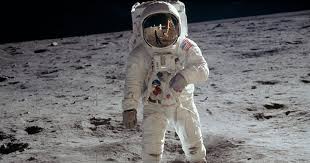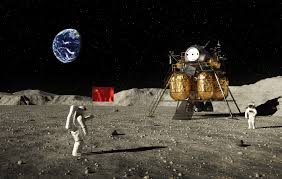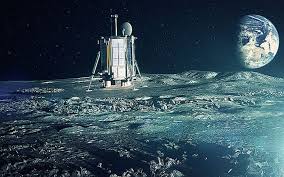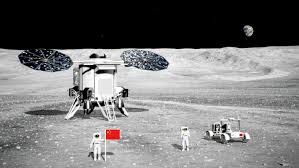Lunar Mission Humanity’s fascination with the Moon has existed for millennia. From early myths and legends to scientific observations, the Moon has been a source of inspiration and curiosity. In modern times, this celestial body has become the focal point of some of the most ambitious space missions. Lunar missions, both past and present, have played a crucial role in advancing our understanding of the universe, and the latest efforts in lunar exploration promise to take humanity to new heights.
Renewed Interest in the Moon

In recent years, there has been a resurgence of interest in lunar missions. This renewed focus stems from several factors, including advancements in technology, the potential for resource extraction, and the Moon’s strategic importance as a stepping stone for deeper space exploration. Nations and private entities are now racing to establish a presence on the Moon, reflecting a growing recognition of its significance for future space endeavors.
Scientific Objectives of Lunar Missions
One of the primary goals of lunar missions is to enhance our scientific understanding of the Moon and its history. The Moon serves as a natural laboratory, preserving records of the early solar system that have been erased on Earth due to geological processes. By studying lunar samples and conducting experiments, scientists aim to uncover insights into the formation of planets, the behavior of celestial bodies, and the history of our own planet.
Another critical area of focus is the search for water ice. Recent discoveries have confirmed the presence of water in permanently shadowed regions near the Moon’s poles. Water ice could provide a sustainable source of life support for future lunar habitats and serve as a critical resource for producing rocket fuel, enabling deeper space missions.
Technological Advancements Driving Lunar Exploration
Technological advancements have played a pivotal role in enabling the next generation of lunar missions. Innovations in spacecraft design, autonomous navigation, and miniaturized scientific instruments have significantly increased the feasibility of exploring the Moon. Advanced propulsion systems and reusable launch vehicles have also reduced costs, making lunar missions more accessible to a wider range of participants.
Robotic missions, such as lunar rovers and landers, have become increasingly sophisticated. These machines are capable of performing complex tasks, including drilling for samples, conducting seismic studies, and creating 3D maps of the lunar surface. In addition, the development of modular lunar habitats and life support systems is paving the way for sustainable human presence on the Moon.
International Collaboration and Competition
 Lunar exploration has become a highly collaborative yet competitive endeavor. Space agencies such as NASA, ESA, Roscosmos, CNSA, and ISRO are working together on various projects while simultaneously pursuing their own missions. International collaborations aim to pool resources, share expertise, and foster peaceful exploration of space.
Lunar exploration has become a highly collaborative yet competitive endeavor. Space agencies such as NASA, ESA, Roscosmos, CNSA, and ISRO are working together on various projects while simultaneously pursuing their own missions. International collaborations aim to pool resources, share expertise, and foster peaceful exploration of space.
For example, the Artemis program, led by NASA, involves partnerships with numerous countries and private companies. This program aims to return humans to the Moon by 2025, establish a sustainable lunar presence, and prepare for missions to Mars. Meanwhile, China’s Chang’e program has made significant strides, including successful lunar landings, rover deployments, and sample return missions.
Despite the spirit of cooperation, geopolitical competition remains a driving force in lunar exploration. The strategic value of the Moon, particularly its potential resources and its role in space dominance, has led to a modern space race reminiscent of the Cold War era.
The Role of Private Companies
Private companies have emerged as key players in lunar exploration. Organizations such as SpaceX, Blue Origin, and Astrobotic are partnering with governments and pursuing their own lunar missions. These companies bring innovation, agility, and cost efficiency to the field, accelerating the pace of progress.
SpaceX’s Starship, for instance, is being developed as a versatile spacecraft capable of delivering cargo and crew to the Moon and beyond. Similarly, Blue Origin’s Blue Moon lander is designed to support scientific research and commercial activities on the lunar surface. These private endeavors not only expand the scope of lunar exploration but also open up opportunities for commercial ventures, including tourism and resource extraction.
Challenges of Lunar Exploration
While the prospects of lunar missions are exciting, they are not without challenges. The harsh lunar environment presents numerous technical and logistical hurdles. Extreme temperature fluctuations, radiation exposure, and the abrasive nature of lunar dust pose risks to both humans and equipment.
Establishing a sustainable presence on the Moon also requires overcoming significant engineering challenges. Developing reliable life support systems, efficient power generation, and effective radiation shielding are critical for long-term habitation. Additionally, the cost of lunar missions remains a major barrier, requiring substantial investment and careful planning.
The Vision of a Lunar Economy
The Moon’s potential as a hub for economic activity is a driving force behind many lunar missions. The extraction of resources, such as helium-3, rare earth elements, and water, could have significant economic implications. Helium-3, for example, is considered a potential fuel for nuclear fusion, offering a clean and abundant energy source.
Moreover, the establishment of a lunar base could facilitate a thriving economy centered on space exploration. From manufacturing in microgravity to launching missions from the Moon’s low-gravity environment, the possibilities are vast. Such developments could transform the Moon into a gateway for exploring the solar system and beyond.
Preparing for Future Lunar Missions

As lunar missions become more ambitious, preparations are underway to ensure their success. Training astronauts for the unique challenges of lunar exploration wdbos is a key priority. Simulated environments, such as lunar analog sites on Earth, provide valuable experience in operating under Moon-like conditions.
Infrastructure development is another area of focus. Projects such as the Lunar Gateway, a space station orbiting the Moon, aim to support long-term missions and serve as a staging point for exploration. Advances in communication and navigation systems are also essential to enable seamless coordination between Earth and lunar activities.
The Broader Impact of Lunar Exploration
The impact of lunar exploration extends far beyond scientific and economic benefits. These missions inspire a sense of wonder and possibility, igniting public interest in space and encouraging the next generation of scientists, engineers, and explorers. They also serve as a reminder of humanity’s capacity for innovation and cooperation.
Furthermore, lunar exploration has the potential to address global challenges. Technologies developed for lunar missions, such as renewable energy systems and sustainable resource management, can have applications on Earth. By pushing the boundaries of what is possible, lunar missions contribute to the advancement of human knowledge and capability.
Looking Ahead
The latest efforts in lunar exploration mark a new era of discovery and innovation. With the combined efforts of governments, private companies, and international organizations, humanity is poised to achieve unprecedented milestones on the Moon. These missions not only deepen our understanding of the universe but also lay the foundation for a future where the Moon becomes an integral part of human civilization.
As we continue to reach for the stars, the Moon remains a symbol of what humanity can achieve when it dares to dream. The journey to the Moon is not just about exploration; it is about defining our place in the cosmos and embracing the infinite possibilities that lie beyond.
